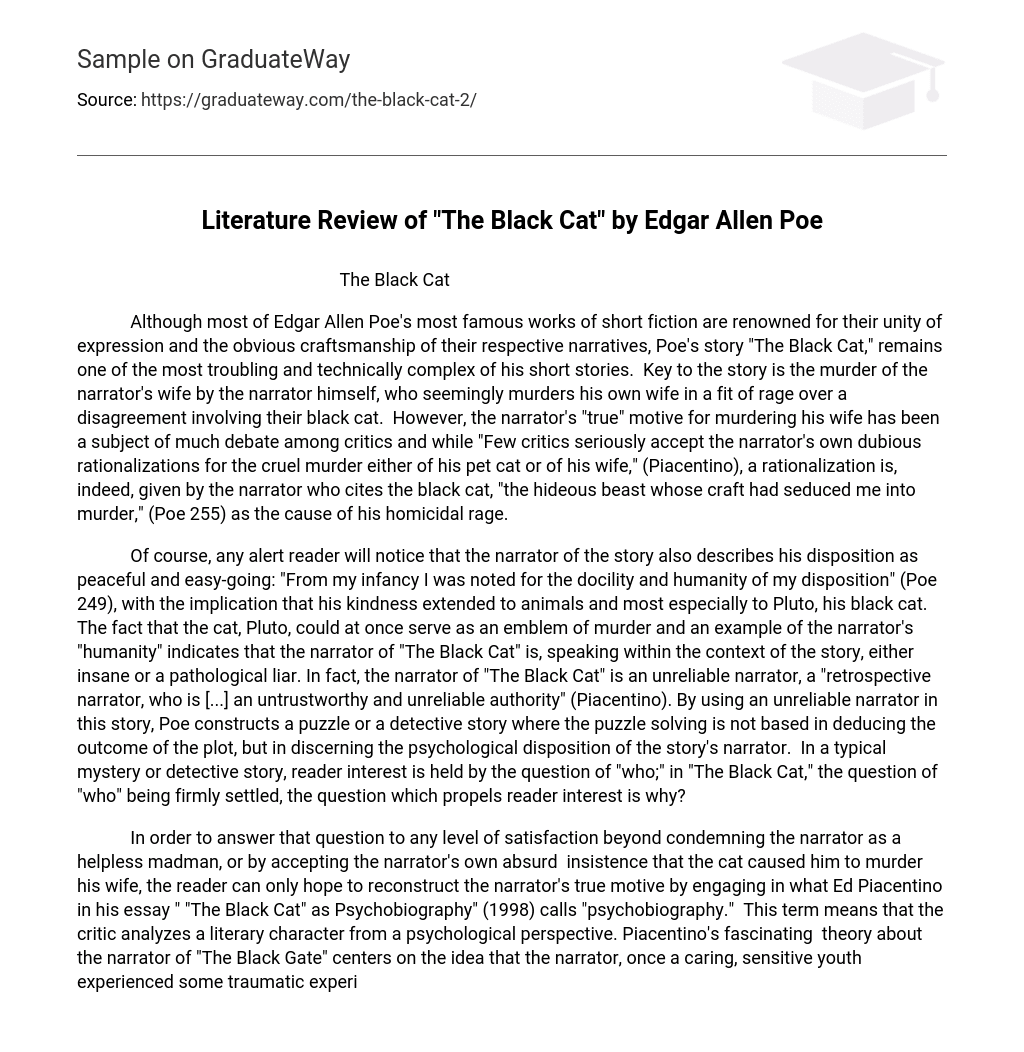Although most of Edgar Allen Poe’s most famous works of short fiction are renowned for their unity of expression and the obvious craftsmanship of their respective narratives, Poe’s story “The Black Cat,” remains one of the most troubling and technically complex of his short stories. Key to the story is the murder of the narrator’s wife by the narrator himself, who seemingly murders his own wife in a fit of rage over a disagreement involving their black cat. However, the narrator’s “true” motive for murdering his wife has been a subject of much debate among critics and while “Few critics seriously accept the narrator’s own dubious rationalizations for the cruel murder either of his pet cat or of his wife,” (Piacentino), a rationalization is, indeed, given by the narrator who cites the black cat, “the hideous beast whose craft had seduced me into murder,” (Poe 255) as the cause of his homicidal rage.
Of course, any alert reader will notice that the narrator of the story also describes his disposition as peaceful and easy-going: “From my infancy I was noted for the docility and humanity of my disposition” (Poe 249), with the implication that his kindness extended to animals and most especially to Pluto, his black cat. The fact that the cat, Pluto, could at once serve as an emblem of murder and an example of the narrator’s “humanity” indicates that the narrator of “The Black Cat” is, speaking within the context of the story, either insane or a pathological liar. In fact, the narrator of “The Black Cat” is an unreliable narrator, a “retrospective narrator, who is […] an untrustworthy and unreliable authority” (Piacentino). By using an unreliable narrator in this story, Poe constructs a puzzle or a detective story where the puzzle solving is not based in deducing the outcome of the plot, but in discerning the psychological disposition of the story’s narrator. In a typical mystery or detective story, reader interest is held by the question of “who;” in “The Black Cat,” the question of “who” being firmly settled, the question which propels reader interest is why?
In order to answer that question to any level of satisfaction beyond condemning the narrator as a helpless madman, or by accepting the narrator’s own absurd insistence that the cat caused him to murder his wife, the reader can only hope to reconstruct the narrator’s true motive by engaging in what Ed Piacentino in his essay ” “The Black Cat” as Psychobiography” (1998) calls “psychobiography.” This term means that the critic analyzes a literary character from a psychological perspective. Piacentino’s fascinating theory about the narrator of “The Black Gate” centers on the idea that the narrator, once a caring, sensitive youth experienced some traumatic experience which caused him to lose his emotional openness and emotional responses. As he became a hardened person, the black cat, Pluto, became a symbol of his lost emotional harmony and — in time — he also began to resent his wife for still being warm and open: “he feels jealousy toward her for possessing a sensitive and caring nature such as he used to possess himself” (Piacentino). By following this logic, the conclusion for the narrator’s motive in murdering his wife is, according to Piacentino, rage over his own lost sensitivities:”His wife’s effort to save the cat becomes […] a reenactment of his own childhood trauma, an event in which he became the victim of friends who made fun of his own sensitivity” (Piacentino). The key to why the murder is cathartic for the narrator is because it completes the sense of alienation which had already, through his childhood trauma, destroy his sense of purpose and fulfillment in life.
Although many readers may reach different conclusion regarding the true motive of the narrator in “The Black Cat,” there is no doubt that Poe’s use of an unreliable narrator for this taut and haunting story establishes a kind of “code” which the reader is left to “break” with his or her own tools and intellect. Certainly, psychobiographical insight, such as that which reveals that the narrator of “The Black Cat” suffered a life-changing trauma in his youth, support the intensity and symbolically-charged complexity of the story, while revealing new facets about the story’s ambiguous and unreliable narrator.
Works Cited
Piacentino, Ed. “Poe’s “The Black Cat” as Psychobiography: Some Reflections on the Narratological Dynamics.” Studies in Short Fiction 35.2 (1998): 153+. Poe, Edgar Allan. Thirty-Two Stories. Ed. Stuart Levine and Susan F. Levine. Indianapolis: Hackett Publishing, 2000.





